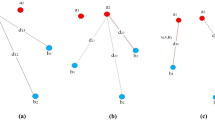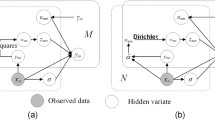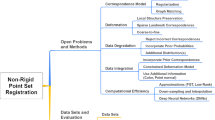Abstract
In this paper, a flexible probabilistic method is introduced for non-rigid point registration, which is motivated by the pioneering research named Coherent Point Drift (CPD). Being different from CPD, our algorithm is robust and outlier-adaptive, which does not need prior information about data such as the appropriate outlier ratio when the point sets are perturbed by outliers. We consider the registration as the alignment of the data (one point set) to a set of Gaussian Mixture Model centroids (the other point set), and initially formulate it as maximizing the likelihood problem, then the problem is solved under Expectation–Maximization (EM) framework. The outlier ratio is also formulated in EM framework and will be updated during the EM iteration. Moreover, we use the volume of the point set region to determine the uniform distribution for modeling the outliers. The resulting registration algorithm exhibits inherent statistical robustness and has an explicit interpretation. The experiments demonstrate that our algorithm outperforms the state-of-the-art method.








Similar content being viewed by others
References
Maintz JBA, Viergever MA (1998) A survey of medical image registration. Med Image Anal 2:1–36
Zitova B, Flusser J (2003) Image registration methods: a survey. Image Vis Comput 21:977–1000
Du S, Zheng N, Ying S, Liu J (2010) Affine iterative closest point algorithm for point set registration. Pattern Recogn Lett 31:791–799
Myronenko A, Song X (2010) Point set registration: coherent point drift. IEEE Trans Pattern Anal Mach Intell 32(12):2262–2275
Rueckert D (2001) Non-rigid registration: techniques and applications. In: Medical Image Registration. CRC Press, London.
Besl PJ, McKay ND (1992) A method for registration of 3-D shapes. IEEE Trans Pattern Anal Mach Intell 14(2):239–256
Zhang Z (1994) Iterative point matching for registration of free-form curves and surfaces. Int J Comput Vis 13(2):119C152
Fitzgibbon AW (2003) Robust registration of 2D and 3D point sets. Image Vis Comput 21(13–14):1145–1153
Amberg B, Romdhani S, Vetter T (2007) Optimal step nonrigid ICP algorithms for surface registration. In: Proceedings of International Conference on Computer Vision and Pattern Recognition, pp 1–8
Tsin Y, Kanade T (2004) A correlation-based approach to robust point set registration. In: Proceedings of European Conference on Computer Vision, pp 558–569
Jian B, Vemuri BC (2005) A robust algorithm for point set registration using mixture of Gaussians. In: Proceedings of IEEE International Conference on Computer Vision, pp 1246–1251
Jian B, Vemuri BC (2011) Robust point set registration using Gaussian mixture models. IEEE Trans Pattern Anal Mach Intell 33:1633–1645
Myronenko A, Song X, Miguel A (2006) Non-rigid point set registration: coherent point drift. In: Proceedings of Neural Information Process Systems
Chui H, Rangarajan A (2000) A feature registration framework using mixture models. In: Proceedings of IEEE workshop on Mathematical Methods in Biomedical Image Analysis, pp 190–197
Chui H, Rangarajan A (2003) A new point matching algorithm for non-rigid registration. Comput Vis Image Underst 89(2–3):114–141
Chui H, Rangarajan A, Zhang J, Leonard CM (2004) Unsupervised learning of an atlas from unlabeled point-sets. IEEE Trans Pattern Anal Mach Intell 26(2):160–172
Horaud R, Forbes F, Yguel M, Dewaele G, Zhang J (2011) Rigid and articulated point registration with expectation conditional maximization. IEEE Trans Pattern Anal Mach Intell 33:587–602
Zhao J, Ma J, Tian J, Ma J, Zhang D (2011) A robust method for vector field learning with application to mismatch removing. In: Proceedings of International Conference on Computer Vision and Pattern Recognition, pp 2977–2984
Bishop CM (2006) Pattern recognition and machine learning. Springer, Heidelberg
Yuille AL, Grzywacz NM (1989) A mathematical analysis of the motion coherence theory. Int J Comput Vis 3:155–175
Acknowledgments
We would like to thank the anonymous reviewers for their constructive comments. This work was funded by National Natural Science Foundation of China (Grant No.61004111) and partly supported by Key Laboratory of Geo-informatics of State Bureau of Surveying and Mapping.
Author information
Authors and Affiliations
Corresponding author
Electronic supplementary material
Below is the link to the electronic supplementary material.
Appendix: The summary of our algorithm
Appendix: The summary of our algorithm

Rights and permissions
About this article
Cite this article
Gao, Y., Ma, J., Zhao, J. et al. A robust and outlier-adaptive method for non-rigid point registration. Pattern Anal Applic 17, 379–388 (2014). https://doi.org/10.1007/s10044-013-0324-z
Received:
Accepted:
Published:
Issue Date:
DOI: https://doi.org/10.1007/s10044-013-0324-z




